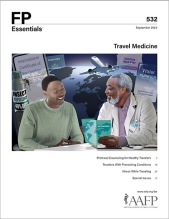
This clinical content conforms to AAFP criteria for CME.
Certain conditions (eg, asthma, diabetes, physical disability, immunocompromise, severe allergies, pregnancy) may increase the risk of travel, but do not necessarily preclude it. Typical age-related physiologic changes also can increase the chances of serious injury or illness. For example, infection with malaria can result in more severe parasitemia in HIV-positive, pregnant, or older travelers. Physicians should evaluate each traveler as an individual, assessing risk tolerance and helping patients decide if the benefits outweigh the definite and potential costs. Extremes of climate and altitude, changes in time zones, and unfamiliar foodstuffs should be given particular attention. The well-prepared traveler should explore options for supplemental insurance, obtain necessary medical records and supplies (including their regular drugs and an appropriate first aid kit), receive education on how to recognize and what to do in the event of a medical emergency, and understand where to find high-quality care abroad.
Case 2. NH is a 2-year-old patient with severe eczema and an allergy to peanuts who is brought to your office by his parents for a pretravel consultation. He recently started receiving monthly dupilumab injections, and his parents AH and BH carry an epinephrine auto-injector. The family will be traveling to Pakistan next week to see AH’s ailing grandmother. BH does not speak Urdu and is concerned about NH being exposed to peanuts. The parents ask if his syringes will be allowed through airport security.
Subscribe
From $350- Immediate, unlimited access to FP Essentials content
- 60 CME credits/year
- AAFP app access
- Print delivery available
Edition Access
$44- Immediate, unlimited access to this edition's content
- 5 CME credits
- AAFP app access
- Print delivery available
